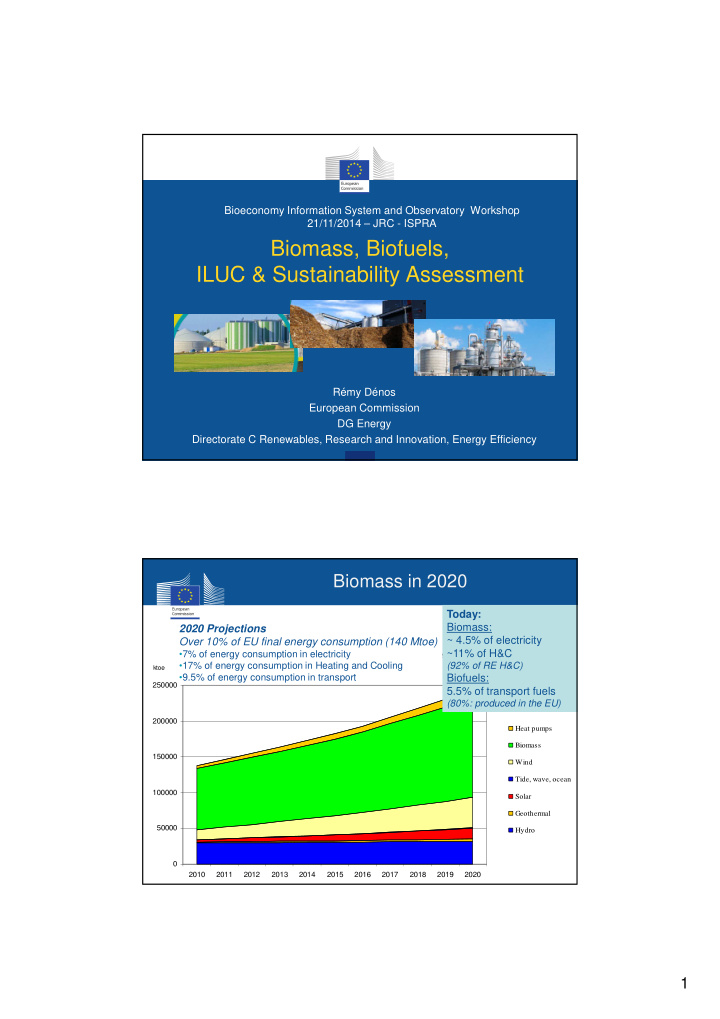



Bioeconomy Information System and Observatory Workshop 21/11/2014 – JRC - ISPRA Biomass, Biofuels, ILUC & Sustainability Assessment Rémy Dénos European Commission DG Energy Directorate C Renewables, Research and Innovation, Energy Efficiency Biomass in 2020 Today: 2020 Projections Biomass: ~ 4.5% of electricity Over 10% of EU final energy consumption (140 Mtoe) Technology Results from the National Renewable Energy Action Plans ~11% of H&C •7% of energy consumption in electricity •17% of energy consumption in Heating and Cooling (92% of RE H&C) ktoe •9.5% of energy consumption in transport Biofuels: 250000 5.5% of transport fuels (80%: produced in the EU) 200000 Heat pumps Biomass 150000 Wind Tide, wave, ocean 100000 Solar Geothermal 50000 Hydro 0 2010 2011 2012 2013 2014 2015 2016 2017 2018 2019 2020 2 1
EU Objectives 2020 2020 2030 2050 GHG emissions -20% (1 - wrt 1990) -40% (5 - wrt 1990) -80% Transport -6% (4 - FQD - wrt 2010) -20% (2, wrt 2008) -60 % (2*, wrt 2008) Share of RE in EU energy consumption 20% (1) (3) 27% (5) Transport 10% (3 - RED) 27% (5) Improvement in Energy Efficiency 20% (1) (6) 30% (5) Biofuels cannot come from land: Binding With high carbon stock (1) 2020 Climate Energy package, 2007 (2) Transport White paper, 2011 * 40% low carbon sustainable fuels in aviation by 2050 High biodiversity (primary forest etc.) (3) Renewable Energy Directive (RED) , 2009, B, NREAP Biofuels need to save at least 35% compared to fossil fuels, increasing to 50% in (4) Fuel Quality Directive (FQD), 2009, B (5) 2030 framework for climate and energy policies, 2014 2017 (6) Energy Efficiency Directive, 2012, B But , indirect impacts not taken into account: - ILUC mandate for the Commission (RED article 19(6)) -> Commission proposal COM (2012) 595 amending RED & FQD 3 Feedstock specific results (gCO2/MJ) IFPRI-study technical findings: Feedstock specific results (gCO2/MJ) Cereals and sugars Vegetable oils Source: Figure 18 of IFPRI-report On average, these emissions would negate around 70% the direct savings offered by biofuels, leaving the average biofuel mix at 22% savings ( biofuels on average still save emissions compared to fossil fuels ). 4 2
Main elements to mitigate ILUC COM : 10% transport target + 5% cap for food crop based biofuels • (applies to RED) • Incentive for advanced biofuels that do no create additional demand for land: accounting 4 times the energy content (RED) • Reporting on estimated carbon stock change due to ILUC (RED+FQD) • Increase minimum greenhouse gas savings for biofuels installations after 07/2014 (RED+FQD) to 60% Council: 10% transport target + 7% cap for food crop based • biofuels (applies to RED) + binding target of 2.5% on advanced biofuels EP: 10% transport target + 6% cap for crop- based biofuels, incl. • energy crops (applies to RED, FQD and public support) and ILUC accounting for FQD + 0.5% non binding target on advanced biofuels 5 Negotiation timeline • Negotiations have been ongoing for two years: • Oct 2012 Commission's proposal • Sep 2013 European Parliament's 1st reading • Jun 2014 Council's political agreement • Transmission from the Council to the EP expected in [January 2015] and EP 2 nd reading will begin • [Finalisation of negotiations expected next year] 6 3
2030 Framework 2020 2030 2050 GHG emissions -20% (1 - wrt 1990) -40% (5 - wrt 1990) -80% Transport -6% (4 - FQD - wrt 2010) -20% (2, wrt 2008) -60 % (2*, wrt 2008) Share of RE in EU energy consumption 20% (1) (3) 27% (5) Transport 10% (3 - RED) 27% Improvement in Energy Efficiency 20% (1) (6) 30% (5) 2030 Framework on biofuels: Binding (1) 2020 Climate Energy package, 2007 (2) Transport White paper, 2011 'The Commission does not think it appropriate to establish new targets for renewable energy or the * 40% low carbon sustainable fuels in aviation by 2050 (3) Renewable Energy Directive (RED) , 2009, B, NREAP greenhouse gas intensity of fuels used in the transport sector or any other sub-sector after 2020‘ (4) Fuel Quality Directive (FQD), 2009, B 'The Commission has already indicated, for example, that food-based biofuels should not receive public (5) 2030 framework for climate and energy policies, 2014 support after 2020‘ (6) Energy Efficiency Directive, 2012, B 'The focus of policy development should be on… second and third generation biofuels and other alternative, sustainable fuels...' Binding at EU Level 7 FP7 2007-2013 400 0 FP7: 50.5 bEur total funding (7 years) Energy: 2.5 bEur (5%) 8 4
Operational Advanced L.EtOH Biofuels Facilities L.EtOH (demo & commercial) L.EtOH Chempolis - Europe Borregaard Inbicon Neste Oil --------------------------------------------------------- --------------------------------------------------------- BioMCN -------------------------------------------------------- -------------------------------------------------------- L.EtOH Clariant Neste Oil L.EtOH L.EtOH Abengoa www.demoplants.bioenergy2020.eu Biomassekraftwerk M&G/Chemtex Güssing 9 H2020 – Call 2015 LCE 11 Developing next generation technologies for biofuels and sustainable alternative fuels – RIA - TRL 3-4 -> 4-5 – 3-6 MEur 05/05/2014 (2 stages) – 60 MEur total budget shared with RIA LCE2 LCE 12 Demonstrating advanced biofuel technologies IA TRL 5-6 – 6-7 5-20 MEur – 80 MEur total budget shared with IA LCE3 LCE14 Market uptake of existing and emerging sustainable bioenergy CSA 1-2 MEur 10 5
Bioeconomy Information System and Observatory Workshop 21/11/2014 – JRC - ISPRA Biomass, Biofuels, ILUC & Sustainability Assessment Rémy Dénos European Commission DG Energy Directorate C Renewables, Research and Innovation, Energy Efficiency 6
Recommend
More recommend